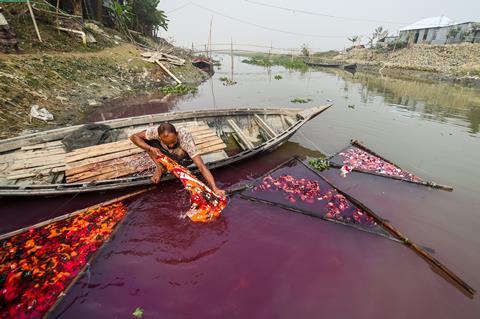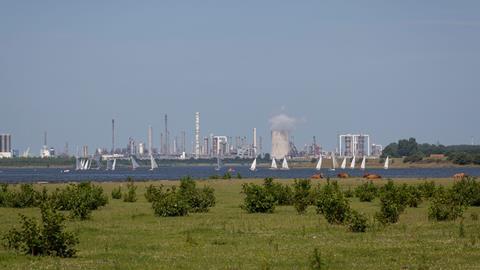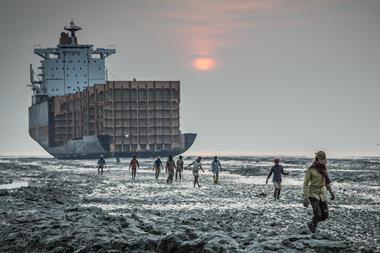With clean water supplies increasingly scarce, Angeli Mehta looks at what industry is doing to reduce its demands
Fresh water is in parlous state. Droughts in South Africa and in Europe in 2018 were a wake-up call to industry. In Cape Town, the city came close to ‘day zero’ with the prospect of taps running dry. ‘We knew it was going to happen, but the fact that it came very quickly and dramatically was unexpected,’ says Kevin Winter, at the Future Water Institute at the University of Cape Town. ‘It caused the public to talk about water like they’ve never done before.’ In Europe, major navigation routes on the Rhine were almost impassable, ships carrying chemicals ran aground and water extraction for cooling was restricted. BASF, Evonik, Solvay and Shell Chemical all had to cut production, and the Germany economy took a hit.
Just 3% of the planet’s water is fresh water, and most of it is locked up as ice in the polar regions and glaciers. Sometimes a lot arrives in the wrong place at the wrong time, but globally fresh water is becoming increasingly scarce. If we carry on polluting and wasting water as we currently are, then by 2030 global demand for fresh water could outstrip supply by 40%.
The water crisis is also destroying biodiversity. Of all the freshwater species that existed on the planet in 1970, just 16% are left. ‘That keeps me awake at night – it’s the most catastrophic decline of all life on earth,’ says Cate Lamb, global director for water security at CDP, an environmental reporting charity. She will champion water at this year’s COP26 climate conference in the UK city of Glasgow and wants to show that while water is threatened by climate change, it also offers huge potential as a mitigation tool.
Each year her organisation asks companies to disclose their water, climate and deforestation risk in response to demand from investors and customers. The latest analysis of responses reveals that of 400 chemical companies asked to disclose, only 266 did. That gap in transparency is troubling, Lamb suggests, because it means institutional investors don’t have the data they need to make informed decisions, and opportunities are missed to push best practice. But reporting doesn’t necessarily mean taking action. While around 70% of chemical companies are monitoring the quality of their water discharge, just 23% of them have set water pollution reduction targets. Many companies remain unaware of the impact their products – from metals to pharmaceuticals – have on water quality. Take textiles: thousands of chemicals are used to make them, of which hundreds persist in the environment and are hazardous to human health. In 2019, the Bangladesh government declared some rivers around garment factories to be biologically dead.
Quantity and quality
Chemical companies stress just how important fresh water is to the viability of their operations and set efficiency targets (see Box A cost–benefit calculation below for examples). But growth means many actually extract more water. ‘Efficiency is not going to cut it. We need these companies to be making more water available to people in places that need it most,’ Lamb says. ‘That means innovating to such an extent that they no longer require the vast volumes of water to be withdrawn and consumed in order to operate.’

While some routes to decarbonisation – biofuels, hydrogen and lithium batteries for example – will increase water consumption, water has huge potential to mitigate climate change. Indeed, 10% of greenhouse gas emissions could be avoided by changing the way water is stored, treated and used. ‘This is where disclosure has a fundamental role to play, because it shines a light on what these trade-offs may well be, and helps a company explore them, and then trigger plans to mitigate them,’ adds Lamb.
While Winter is concerned about water supply, he’s more worried about water quality. The good news is that in the US, Japan and northern Europe releases of hazardous chemicals to surface waters are falling. But the picture isn’t completely rosy. ‘Emerging contaminants are one of the serious areas of research and frontiers for development right now,’ Winter suggests. ‘We need to become more detailed and determined in monitoring so that we can understand exactly what’s happening to our rivers that are becoming increasingly contaminated with high levels of nutrients, bacteria and other chemicals.’
Winter is part of a number of teams across the world using what he calls biofilters – or constructed wetlands. In his research project, water from an informal settlement flows through a combination of stones and peach pips (providing a carbon source), which encourage a diversity of anaerobic microbes. These create biofilms that adhere to the stones, trapping bacteria, phosphates and residues of antiretroviral drugs used to treat HIV.
A cost–benefit calculation
Companies have begun to understand the potential costs of the global water crisis – CDP’s analysis suggests business as usual will cost it five times as much as mitigation. Cosmetics group L’Oreal put the combined potential cost of water rationing and disruption to production at $16.8 million for two facilities in Mexico and Israel.
How do we use data to understand how are we using water within our operation?
Mexico is the fifth company site to become a ‘waterloop’ factory, where the only withdrawals of water are for human consumption and as a raw material in its products. The company adapted technologies used to produce clean water for cities, so they worked on a much smaller scale. An attention to monitoring at all its sites has led to a 33% absolute reduction in water consumption since 2009, and it anticipates all 39 of its production sites will meet waterloop standards by 2030.
South Africa’s water shortage led Proctor & Gamble to initiate the ‘50 litre home’ coalition of companies, policy makers and communities to show how it will be possible for people to live comfortably using just 50 litres of water a day. That’s the minimum the WHO says is required to meet a person’s most basic needs. Today dwellings in Europe and the US can get through 300–500 litres a day. Innovation groups working on P&G’s own consumption will investigate how advances could be adapted for the home. A pilot EU project on a liquid detergent production line at one of its plants in China used a combination of nanofiltration and membrane bioreactor technologies to recover water and detergent from equipment rinsing water, recycling the recovered water back into its cooling towers. Apart from applying physical, chemical and biological technologies to treat and re-use water within its plants, P&G is also using data analytics. For Katherine Brown, a chemical engineer who leads the company’s water stewardship programme, the question is ‘How do we take data that we already have and use it to understand how are we using water within our operation, and how does that water usage link to different products that we’re producing?’
Another priority is to find technologies ‘that have the lowest energy impact, as well as an impact on waste, but also maximise water recycling,’ Brown explains. ‘Part of that challenge is how we bring these technologies into our plants at an affordable cost.’
Tailor-made
Another unlikely setting in the Netherlands might provide some answers as to how the chemical industry can clean up and close the loop on water. At Dow’s massive chemicals site at Terneuzen, 17 plants – including three ethylene crackers – use around 22 billion litres of fresh water a year to make over 800 different chemicals and plastics. Its freshwater consumption amounts to about two thirds of the area’s industrial water use. For the past few years Dow has been involved in an ambitious programme to develop a toolkit that harnesses nature’s ability to filter out micropollutants, alongside technical and chemical solutions.

As well as working with European industry, the project – called WaterNexus – is developing pilots in some of the world’s most highly stressed river basins including Vietnam, Indonesia and Bangladesh. Decision-making tools for water authorities complement hard and soft technologies to develop water self-sufficiency. ‘We’re not done but we paved the road a bit – building awareness of the possibilities to recharge groundwater resources and share water with others also in the queue,’ says environmental technologist Katarzyna Kujawa of Wageningen University in the Netherlands, who manages those international efforts.
‘Each industry [does not] need the same water quality. For metals or leather or textiles, drinking water quality is not needed. You can tailor circular water approaches to the quality needed in that industrial context,’ suggests Huub Rijnaarts of Wageningen University, scientific coordinator of the WaterNexus programme.
Dow’s goal is to cut its water intake at six sites across the world that are identified as being in stressed catchments. Terneuzen is one, explains Dow water specialist Niels Groot, and he expects the research here can be applied to other locations. Dow’s cooling towers get though six billion litres of water a year. The chemicals it adds to prevent corrosion, scaling and the build up of bacteria limit its reuse. As water evaporates the concentration of salt increases in what remains, and it’s eventually discharged to the local estuary.
Build a wetland
WaterNexus envisages a paradigm shift ‘seeing saltwater as a valuable resource instead of a waste’, explains Thomas Wagner, an environmental chemist at Wageningen University. The aim is for industry to use saltwater when possible and freshwater only when it’s really necessary. Wagner’s PhD research provided proof of concept that a constructed wetland could help Dow reuse the water.
Rather like a pond, the constructed wetland is separated from ground and surface water by a barrier. A series of basins are filled with a substrate, like sand or gravel – through which the water can flow – and plants (such as reeds) that like to have their roots in water. Bacteria start to grow; the plants take up water and contaminants, as can the substrate. ‘By all these processes together, you remove pollutants from the water,’ says Wagner.
Wetland research used to be this black box, where we didn’t really understand what happens
It took a year for some of the contaminants to be completely removed. Adjusting water flow and direction produced different communities of microbes that could deal with the different chemical constituents of the cooling water.
Allowing the water to flow continuously and horizontally created a saturated system without much oxygen and a community of anaerobic organisms. Nitrates and phosphates were removed. Pumping water from above and letting it flow in batches allows oxygen to enter the system again and encourages the growth of bacteria that like aerobic conditions. Here cooling tower corrosion inhibitors can be dealt with.
The concept of a constructed wetland has been around for many years but in the past decade research has accelerated, Wagner explains. ‘Wetland research used to be this black box, where you put something in and something comes out, but we didn’t really understand what happens,’ he says. ‘And now with increased possibilities of analysing pollutants in very low concentrations, and [detecting] for instance, microbial communities that are in these wetlands, we are capable of understanding these processes way better.’
Two issues remain. The amount of land required, and whether the treated water will be suitable for Dow’s desalination system. The membrane system it uses is highly susceptible to scaling and biological fouling. ‘It’s a nightmare. You have to clean [the membranes] fairly regularly. And that’s at the cost of chemicals and energy and recovery efficiency. So if we are able to manage that biological stability with the wetland then that’s really a winning scenario,’ says Groot. ‘So far, it looks pretty promising.’
In the meantime Dow is also working on the wetland concept with the local water company, Evides Industriewater. It has committed to eliminating the 4–5 billion litres it takes every year from the Biesbosch – one of the last extensive freshwater tidal wetlands in Europe.
The idea is to replace it with treated wastewater from the city of Terneuzen, as well as more of its own effluent and rainwater. The project will go further, to examine the wetland’s ability to absorb micropollutants like pesticides and pharmaceutical residues, and if successful will cut both water and carbon footprints. The new treatment step will be compared to current, proven technologies including biological activated carbon filters. The two companies are investigating all aspects of the project – from energy, chemical and materials input to wetland maintenance and project costs – to decide which option to implement. Evides’ project developer Bas van Eijk expects both partners will gain insights that can be used at other sites. He anticipates a new system will be operating in 2024.
Greening the desert
The world’s largest constructed wetland is located in the desert in southern Oman, where it handles the oily wastewater from the Nimr oilfields. In the past the water would have been re-injected into aquifers – an energy-intensive system that’s expensive to operate and maintain, and runs the risk of contamination.
The bulk of the oil is removed from the water using hydrocyclone units that subjects the mixture at centrifugal forces up to 1000 times that of gravity. The oil is recovered and the water outflow goes into a series of constructed wetlands. Energy demand for treatment is now close to zero.
We don’t push the water through a membrane, but we drag the salt ions out of the water
The wetlands have brought biodiversity to this desert site, but the water is mostly lost to evaporation. To use it for irrigation, for example, salts and residual chemicals would have to be removed. For Rijnaarts, this is one of the most pressing research questions. To address it, he’s working with Shell at its gas-to-liquids plant near Doha, in Qatar, alongside local research institutes. Here diesel, aviation fuel and synthetic oils for lubricants are produced. Can the water be re-used to green the desert and develop non-food agriculture?
Today, a widely used desalination technique is reverse osmosis, whereby water is pushed through a membrane and the salt retained. It’s an energy intense process. Indeed, by 2040 it’s estimated that desalination will account for more than 20% of water-related global electricity demand.
The team is working on electrode membrane techniques. ‘We don’t push the water through a membrane, but we drag the salt ions out of the water. By using that approach, we can decrease the amount of energy that is needed,’ Rijnaarts says.
It’s also developing technologies to make the process targeted, so only harmful ions such as sodium, would be removed. ‘However, achieving such a specificity is fairly difficult, but a nice task for us technological scientists to chew on,’ he says.
Rijnaarts is convinced industry understands that business as usual threatens the availability of their main production resource – and they’d rather be the ones to come up with solutions to the water crisis. ‘I’ve worked with a lot of parties around the world, and I know that industry can get things done. If they step up, they can be a powerful force for sustainability.’
Later this year, nations will meet to agree how much protection to afford the planet’s water and land. Will the chemical industry step up and put us on a path to a more water secure world?
Angeli Mehta is a science writer based in Edinburgh, UK













No comments yet